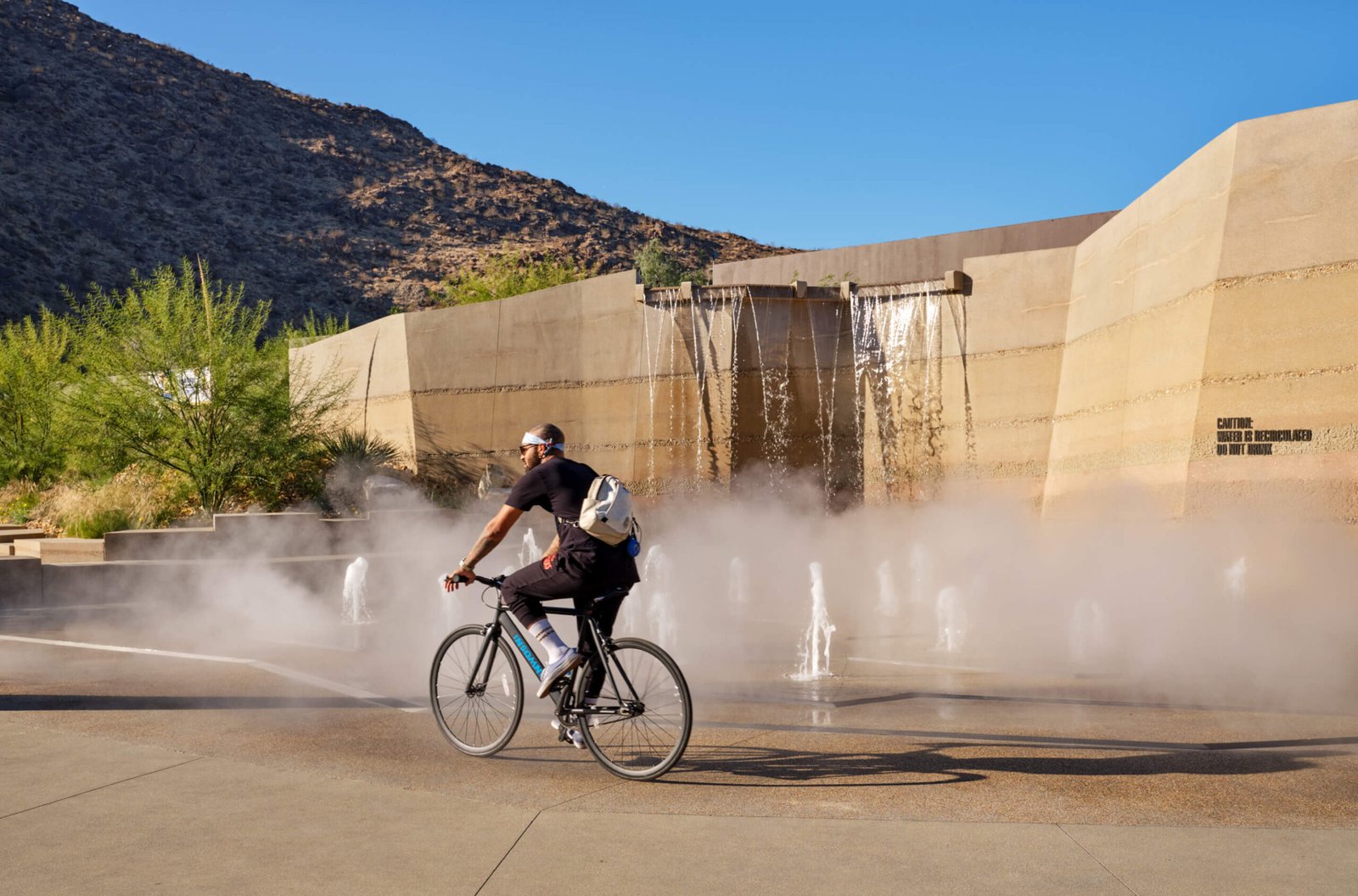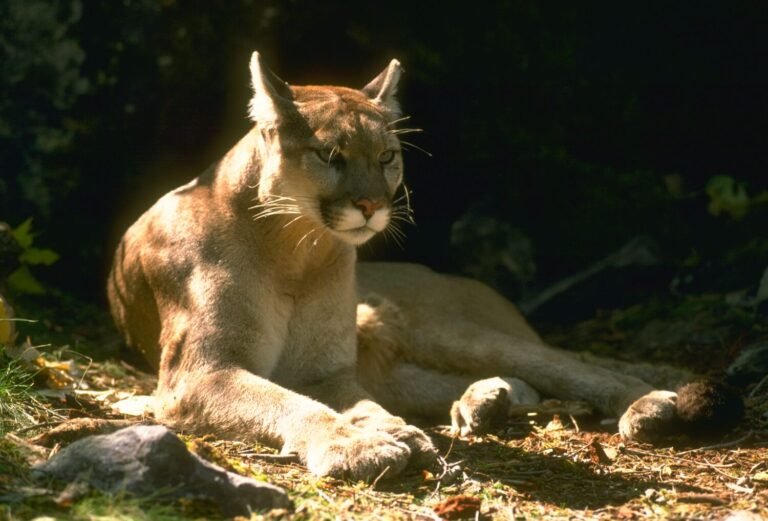Palm Springs’ Downtown Park seems past the desert metropolis’s midcentury heyday
While there’s no shortage of first ladies, influential female movers-and-shakers, businesswomen, and doyennes of all stripes associated with Palm Springs—Dinah Shore, Mary Pickford, Lucille Ball, Marilyn Monroe, Gigi Guggenheim, the Gabor sisters, Pearl McCallum McManus, Ruth Hardy, and Barbara Foster Henderson, to name just a few—there is only one mother: the inimitable Nellie Coffman.
Entrepreneur, promoter, philanthropist, and proprietress of fabled sanatorium-turned-celebrity-escape the Desert Inn, Coffman is credited with putting Palm Springs, then a lonely and far-flung outpost in California’s Sonoran Desert, on the map as a place to be seen with the opening of the inn in 1909. Her formidable legacy has now come into renewed focus with the opening of a 1.5-acre public park at the site of the long-gone Desert Inn.
Designed by Los Angeles-based multidisciplinary architecture and design firm RIOS, the city’s new Downtown Park debuted this past October after breaking ground in 2019 and will enjoy a second major wave of attention during the 2022 edition of Modernism Week, which kicks off on February 17. (During the annual celebration of Palm Spring’s rich midcentury modern architecture and design heritage, RIOS is hosting four sold-out walking tours of Downtown Park.)
As Nate Cormier, managing director of the landscape architecture practice at RIOS, explained to AN, Coffman, in the role of Palm Springs’ earliest and most emphatic booster, would stress the “four S’s” when persuading people why they needed to visit or put down roots in the city: “Space, stillness, solitude, and simplicity.”

“During the early design stages, you start out with lots of different ideas—it’s always an editing process […] and you’ve got to prioritize which ideas are really true to the identity of this place,” said Cormier. “At an early point in the process, we started using her four “S’s” almost like a litmus test—which idea is space stillness, solitude, and simplicity? It became a mantra.”
Featuring a bench-lined native palm grove, an event stage with amphitheater-style seating, two spacious lawns, public unisex restrooms, police substation, and a grotto-like water feature, the resultant Downtown Park pays homage to the healing desert landscape that Coffman so tirelessly championed.
To that end, the $7.6 million park’s design notably eschews riffing off midcentury design. “We made a conscious decision to try to tap into this intrinsic landscape, something more eternal and timeless about Palm Springs,” said Cormier. “We wanted to give people a taste of this place, like in wine culture they call it terroir. If you visited [Palm Springs] for just a brief time and went to this park, you get a little hint at some other experiences that really are unique in the world.”

Dubbed the Spring and designed in partnership with Fluidity Design Consultants, the dramatic cascading water feature, for example, draws direct inspiration from a 60-foot waterfall found at Tahquitz Canyon within the Agua Caliente Band of Cahuilla Indians Reservation. Meanwhile, the park’s resident palms are real California palms: the endemic Washingtonia filifera, bearded and irregular, and not non-native species like the Mexican fan palm, which came to dominate the Southern California landscape during the 1930s. The unique geology observed by the design team during field expeditions into the San Jacinto Mountains was replicated via a custom sedimentary finish for the park’s vertical walls and modular seat blocks.
In addition to an “overall vibe that immerses people in the native landscape,” Cormier noted that the park was “always intended to be a catalyst for the rest of downtown Palm Springs.” It serves a crucial civic function in a city that, despite being a world-famous destination for outdoor recreation and leisure activities, has until now lacked a proper commons—a multifaceted, open-air venue for residents and visitors alike to gather in its downtown core. (Located a block west of North Palm Canyon Drive, the park is bounded by Belardo Road and North Museum Drive and opposite the Palm Springs Art Museum; towering over Museum Way to the south is the controversial, colossal Forever Marilyn.)
While outdoor social interaction in and around Palm Springs tends to take place on the golf course and at the pool deck, the Downtown Park offers an alternative: an inviting swath of open public space envisioned by Palm Springs City Council as “a central arts and culture hub” for the city. Importantly, the all-seasons park is accessible during even the most blazing hot desert afternoons thanks to its highly climate-responsive design that offers shade—and cooling mist from the Spring’s fog bank feature—in abundance.

“It provides a place for people to have an ice cream cone and stroll or have a cup of coffee, but also taps into a few other larger bioregional and cultural forces afoot in the Coachella Valley,” Cormier said. And while the multigenerational Downtown Park offers what Cormier called “a playful and dynamic atmosphere” that’s family-friendly, design elements also specifically cater to Palm Springs residents, who skew gay and older. To better accommodate older visitors, for example, the park’s benches, feature generous armrests designed so that users can more easily help themselves up after sitting. The armrests also bring pops of color, a signature of RIOS’s, into the park’s predominately natural tones.
Following the drawn-out demolition of the Desert Inn that began in 1966, a different sort of gathering place—one very much of the era—rose to take its place: the Desert Inn Fashion Plaza, an enclosed shopping mall designed by Charles Luckman and later anchored by a SOM-designed department store for high-end San Francisco retailer Joseph Magnin Co.
Coffman’s sons sold the inn to actress Marion Davies in 1955 several years after their mother’s death, and a plan was hatched to redevelop the property into a Las Vegas-style resort complex designed by Victor Gruen and Associates. That plan was scrapped and Davies went on to sell the land in 1960 to developers Samuel Firks and George Alexander for $2.5 million. A subsequent redevelopment scheme fell through and the property was eventually acquired by developer Joseph K. Eichenbaum. Following its 1967 opening, the mall rebranded as the Desert Fashion Plaza in the 1980s following a major overhaul and experienced initial success. In the decades that followed, it persevered through multiple ownership shifts and expansions both scrapped and realized before entering a period of decline in the 1990s. The demolition of the vacant Desert Fashion Plaza commenced in 2013 to make way for a mixed-use redevelopment scheme featuring a Kimpton hotel, retail, and open public space. Conceptual plans for Downtown Park, which constitutes just a sliver of the old Desert Inn/Desert Fashion Plaza site, kicked off in 2015.

The Downtown Park celebrates the Palm Springs of Nellie Coffman through its embrace of the natural landscape and, fittingly, a bronze plaque at the park sponsored by the nonprofit Palm Spring Preservation Foundation (PSPF) marks the historic significance of the site. The PSPF is also campaigning for the city to name the new park in her honor.
“The city has a tradition and long history of naming its parks after female pioneers like Frances Stevens and Ruth Hardy,” wrote PSPF president Tracy Conrad in a December 2020 op-ed published in the Desert Sun. “It is only fitting that we remember this history and name the new downtown park after Coffman, the most important civic leader of the 20th century, as it is the very ground, the hallowed place, where she walked and worked.”
As recounted by Cormier, PSPF members distributed “little Nellie heads” (technically “face fans”) at the October 21 grand opening festivities, which, in true Palm Springs fashion, included a concert by an ABBA tribute band and a dog parade. “I’d say we’re very supportive,” he said. “I do think it would be really wonderful to name the park after her.”


